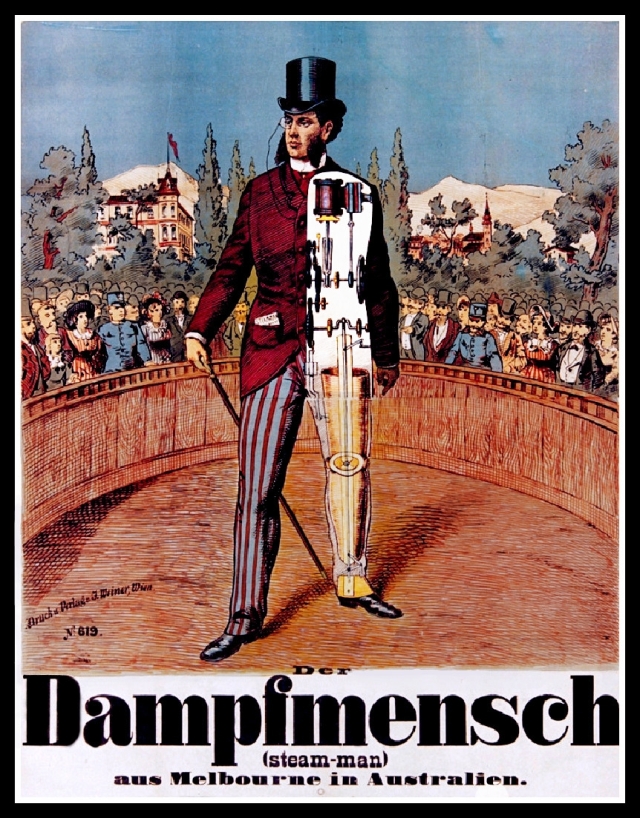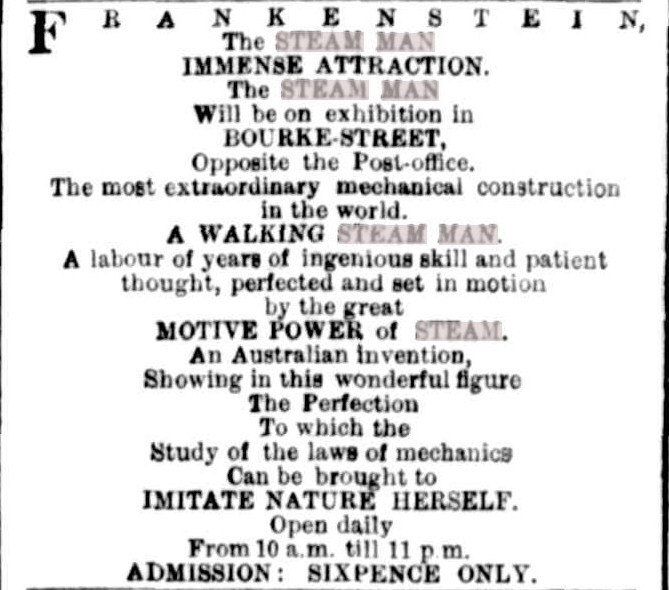
Being an Australian myself, I got very excited when I found out about this Steam Man from Australia. Despite many hours in the State Library of Victoria, I have not been able to find any photos of him. However, as it was on show for major exhibitions, there was plenty of coverage in the local press.
Hornburg built at least three walking automatons, "Graaf von Frankenstein," the man with the Iron Lungs that was exhibited in Sydney and Melbourne, and likewise of the steam man "Parnell," a figure that attracted great attention when first shown. His latest automaton has been christened "Adam Iron." The poster above is most likely that of "Parnell".
**Update: 18 March 2010 – DoubleM2 on Flickr kindly sent me an image of an Austrian poster of Hornburg's Der Dampfmensch (Steam-Man) now shown in this post.
Poster details:
Document Type Poster
German Language
Title Der Dampfmensch steam. – Man
Publisher Wien (Vienna): J. Weiner [1880]
J. Weiner
Snack 1 is. (poster) lithogr. en coul. 0.95 x 1.24 m
Note: RH 2010 The Melbourne Exhibition of 1880 included an exhibit from Austria, so it is quite possible the lithograph was made by someone associated with that exhibit.
The Melbourne International Exhibition was held from 1 October 1880 until 30 April 1881. It was the second international exhibition to be held in Australia (then Victoria), the first being held the previous year in Sydney. 1.5 million people visited the exhibition (including repeat visitors). The population of Melbourne at the time was 280,000.
The Royal Exhibition Building, set in the Victorian Carlton Gardens was completed in 1880 to host the exhibition, consisting of over 12,000 square metres of floorspace and temporary annexes.
The exhibition was modeled on the great exhibitions of Europe, with an aim to promote commerce and industry, along with art, science and education. They also served as a form of entertainment and tourism.
Sydney Morning Herald Mon, 27 September 1880
Note on the name "Frankenstein" : Frankenstein, or The Modern Prometheus, is a novel written by Mary Shelley. Shelley started writing the story when she was 18 and the novel was published in 1818 when she was 19. The title of the novel refers to a scientist, Victor Frankenstein, who learns how to create life and creates a being in the likeness of man, but larger than average and more powerful. In popular culture, even before the films were made, people have tended incorrectly to refer to the monster as "Frankenstein". This is also the case here.
Sydney Morning Herald 8 October 1880
Sydney Morning Herald – 17 October, 1880
The Maitland Mercury 28 Sep 1880 p2
AN INGENIOUS AUTOMATON.
After a year of patient labour, a very ingenious automaton has just been completed by Mr. Hornburg, of 535, George St.[Sydney, N.S.W.] Its speciality is that it walks-walks in the same style and with much the same motion as a human being does. The place occupied by lungs, heart, and other indispensable organs in the human frame are represented in Frankenstein-Mr. Hornburg's creation-by machinery ; and the rattling and gasping sounds which emanate from him would be anything but reassuring it they followed the exertion of gentle walking, when undertaken by an ordinary person.
Frankenstein is about 5 feet 6 inches high ; and his wooden head has been carved and painted into the shadowy semblance of a well-known politician. He is well dressed, and as he stands at ease has a vacuity of gaze and a general listlessness of demeanour which are triumphs of gentlemanly impassiveness.
His motive power is steam, supplied to him by means of a horizontal tube, on which one hand rests.
This tube is connected at one end with a little tall upright exhaust pipe, into which the steam from a little engine close by passes. As the automaton man moves, an eccentric in the hip revolves, and lever action bends the knee, raises the toes from the ground, and throws the foot forward. Then the foot drops, and the other repeats the action, the imitation of walking being very good. On Saturday the invention is to be shown in the vestibule of what was the Victoria Theatre. -Echo
The Argus, 13 November 1880

The Argus, 16 November 1880
THE MELBOURNE EXHIBITION.
Star , Issue 3944, 8 December 1880, Page 3
THE MELBOURNE EXHIBITION.
4 (Written specially for the Lyttelton Times.) [By Gabnbt Waxch.] No. IV. Exhibitions ot the future— exits and entrances— The Steam Man— ………. Amongst the exhibits not at tho Exhibition is that really overwhelming curiosity, the steam man. I mako it my duty to inspect every now "show" that is announced, whether it be a five-legged calf, a lady without hands, a temperance lecturer, a giant or a dwarf. In this case, it is the steam man. Truly, as Hamlet says, " what a wonderful piece of work is a (steam) man." Outside on the pavement, where the leather-lunged orator bids all and sundry to pay their expenses, and enjoy the intellectual treat within provided for them ; outside, I say, I'm shown the representation of a figure, all lavishly endowed with levers, cranks and wreathed screws as his mortal prototype is with nerves, sinews and muscles. Inside you are ushered into the presence of a Guy Fawkes, mask faced, scare-crow-clothed horror, whose bared breast discloses a battered iron plate, whose side — Siamese twin-like — is pierced by a pipe and shaft in one, and whose performance consists in a hobbling, shuffiling, two steps forward, one step backwards sort of semi-slide round and round and round a circle some six feet in diameter. This is the steam man, and this, mark the moral, is an independent, non- State-supported Exhibition, which, with its daily average takings of some £14, nineteen-twentieths profit, puts the Carlton Garden's white elephant into the limbo of unsuccessful monstrosities. Next to being the sole proprietor of the steam man, X should like to be one of the partners in the "Holy Land " stall at the Exhibition. ………….
The Ohio Democrat 03 Feb 1881 p4 (similar to Maitland Mercury above)
A Walking Automaton.
After a year of patient labor, a very ingenious automaton, says the Sydney (Australia) Herald, has just been completed by Mr. Hornburg, of Sydney. Its specialty is that it walks -walks in the same style and with much the same motion as a human being does. The place occupied by lungs, heart and other indispensable organs in the human frame are represented in Frankenstein— Mr. Hornburg's creation— by machinery: and the rattling and gasping sounds which emanate from him would be anything but reassuring if they followed the 'exertion of gentle walking when undertaken by an ordinary person.
Frankenstein is about five feet six inches high; his motive power is steam, supplied to him by means of a horizontal tube, on which one hand rests. This tube is connected at one end with a tall upright exhaust pipe, into which the steam from a little engine close by passes. As the automaton man moves an eccentric in the hip revolves and level action bends the knee, raises the toes from the ground and throws the foot forward. Then the foot drops and the other one repeats the action, the imitation of walking being very good.
The last report on Hornburg(h) in 1882 was from Tasmania (Australia), and the newest automaton was now called "Adam Iron" (The American C.C. Roe also called his Steam Man "Adam Ironsides" .) The article is also suggestive in that the 'iron man' is no longer powered by steam, and now is 'wound' up, indicating a change to clockwork spring power. Steam power would not be satisfactory for indoor showing.
The Mercury (Tasmania) 16 May 1882
The Mercury (Tasmania) 1 July 1882
The Mercury – Tue 4 July 1882
The following text is from The Launceston Examiner 11 May 1882. It further describes "Adam Iron", and two previous walking automatons, "Graaf von Frankenstein" and the steam-powered "Parnell". So at least 3 automatons were made by Hornburg.
A NOVEL INVENTION. There is an old proverb that has been extensively quoted from generation to generation, affirming that "There is nothing new under the sun." This assertion, like many other "wise news," has been frequently practically contradicted, and the misleading sentiment contained in it effectively exposed. An instance that something at least of a novel nature is brought to light occasionally has occurred in Launceston, which can now boast of being the first town that has produced an iron man, who can walk, like his brethren in flesh, without the aid of steamn- a power that has been previously brought into use in propelling a somewhat similar automaton. The curious piece of mechanism we refer to is the invention of Mr. Hornburg, a mechanical engineer, who has earned great praise from both the press and public in the neighbouring colonies for his exceptional abilities. The figure, which is dressed as a footman, is 5ft 10in in height, and weighs 1601bs. Its actions arise from the powers of a spring concealed in its inside, which enables it to walk with the greatest ease and wheel a man's perambulator before it. With the assistance of an ingenious piece of mechanism an eccentric motion is obtained, which by the help of levers causes the legs to ascend and descend, similar to the walking movements of a human being. The actions of the spring are controlled by a break, and the figure can walk about 200 yards, without stopping, after being wound up. The perambulator is also constructed upon a new plan, and is of exceptional strength. It is fitted with two large iron wheels, and a smaller one. Each of these wheels has a double row of iron spokes, which can be taken to pieces in the space of two minutes, by unscreowing the nut at the head of the axle. The head of the automaton is made of wood, and moves as the figure walks. The labour of invention has occupied Mr. Hornburg nine nmonths, and he is to be congratulated upon his perseverance and ultimate s success. This gentleman has earned a reputation as an inventor of large automatons throughout the other colonies, he being also the originator of "Graaf von Frankenstein," " the man with the Iron Lungs," that was exhibited in Sydney and Melbourne some eighteen months ago, and likewise of the steam man "Parnell," a figure that attracted great attention when first shown. This, his latest automaton, has been christened "Adam Iron," on account of its being the first figure of its class that has walked without the help of steam. Mr. Hornburg intends to exhibit his invention at the Mechanics' Institute on Monday next, when we would advise all those who wish to see the performances of a really cleverly made automaton not to miss the opportunity offered.
I haven't been able to find much information about Mr. Hornburg. There is only one Hornburg in the Sydney directories of the time (1880), and it was for Mr. Frederick Hornburg, an engineer residing at 3553/415 Pitts Street, Sydney, N.S.W.
There is a Naturalization document for Frederick Hornburg as well.
